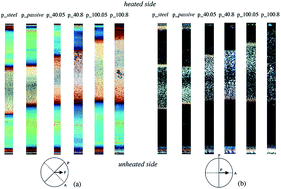Fast mold surface temperature evolution: relevance of asymmetric surface heating for morphology of iPP molded samples
Abstract
It is widely accepted that mold temperature has a strong effect on the amount of molecular orientation and morphology developed in a non-isothermal flowing melt. In this work, this effect was investigated in fast and asymmetric thermal conditions. Therefore, a well-characterized isotactic polypropylene was injected in a rectangular mold cavity conditioned by a purpose developed thin electric heater. Temperature evolution on the mold surface influences the cooling rates near the surface that, in turn, reduces flow stresses and facilitates molecular relaxation. Moreover, asymmetrical thermal conditions have a strong influence on the melt flow field by changing its distribution along the cavity thickness. As a consequence, the morphology distribution of the molded samples was asymmetric and showed complex and peculiar features. It was accurately characterized by optical microscopy and FESEM analysis and compared with the orientation distribution obtained by birefringence measurements.


 Please wait while we load your content...
Please wait while we load your content...